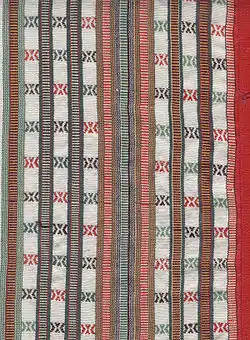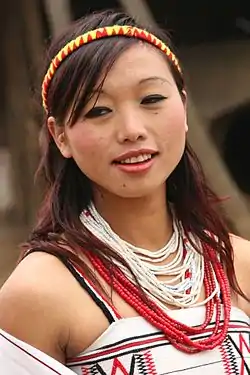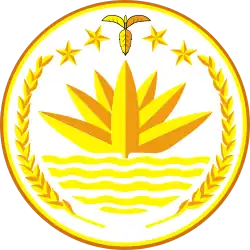Tripuri people
The Tripuri (also known as Tipra,Tiprasa, Twipra) are an ethnic group originating in the Indian state of Tripura. They are the inhabitants of the Twipra/Tripura Kingdom in North-East India and Bangladesh. The Tripuri people through the Manikya dynasty ruled the Kingdom of Tripura for many years until the kingdom joined the Indian Union on 15 October 1949. Under the presidency of Queen Kanchan Prava Devi, mother of Kirit Bikram Kishore Deb Barman.
| Regions with significant populations | |
|---|---|
| 3.5 million India and Bangladesh | |
| Languages | |
| Kokborok(Tripuri) | |
| Religion | |
| Related ethnic groups | |
|
History

Tripuris are the native people of Tripura having its own unique and distinct rich culture, tradition, and history. They were able to expand their influence as far south as Chittagong, as far west as Comilla and Noakhali (known during the British period as 'plains Tipperah')and as far north as Sylhet (all in present Bangladesh). In the year 1512, the Tipperas were at the height of their supremacy when they defeated the Mughals. The ruling dynasty passed through several periods of history and ruled Tripura for several centuries until the 18th century, after which Plain Tippera became a colony of Britain and Hill Tippera remained an Independent Princely State. On 14 October 1949, Hill Tippera was merged into the newly independent India as Tripura State.
Language
The Tripuri people mainly speak dialects of Kokborok, the language which comprises the standard dialects of Debbarma, Tripura, Murasing, Jamatia, Noatia, Reang(Bru), Koloi, Uchoi, and Rupini, Riam Chong language of Halams also spoken across the state and mostly in TTAADC areas. Kokborok is a official language of Tripura. There are estimated to be more than one million speakers of the dialects of Tripuri in Tripura, and additional speakers in Mizoram and Assam in India, and in Nepal, as well as Sylhet and the Chittagong Hill Tracts in Bangladesh.
Religion
According to the 2011 census, 92.50% of the Tripuri people are Hindus & 7.5% of the Tripuri people are Christians (majority Baptists). Almost 85% of Uchoi (Tripuri sub-tribe) are Christians.[1]
Society

The indigenous Tripuri people comprise hill communities, each with its own elementary social and administrative organisation starting from the village level and up to the chieftainship of the whole tribe. [2]
These indigenous communities enjoy their traditional freedom based on the concept of self-determination. The relation between the king and the subject communities was as Maharaja (king) of Tripura-Missip or liaison officer Roy or headman of the community – Sardar the chief of the village – the individual. Earlier, only the Debbarma or Tipra ethnic group was included in the Tripuri Kshatriya group. Later, the Raja included other groups like Reang, Jamatia and Noatia as well, in an attempt to foster a sense of kindness among the people under his region.[3]
The Tripuri people have a rich historical, social, and cultural heritage which is totally distinct from that of the mainland Indians. Their distinctive culture – as reflected in their dance, music, festivals, management of community affairs, dress and food habits – has a strong base. Kokborok, the lingua franca of the 12 largest linguistic groups of the indigenous Tripuris and other dialects spoken in Tripura are of the Tibeto-Burman group and distinct from those spoken in India. There is no influence from those spoken by other peoples in the north-eastern region.
The main Tripuri clans are:
Tripuri games and sports
Like many parts of the world the Tripuri has traditional sports. It is common in almost all the clans of Tripuri. They are called thwngmung in Tripuri. Nowadays these traditional sports are being abandoned gradually, as Tripuris are attracted to modern games and sports. But some of the sports still played and preferred in rural Tripura.
Notable people
- Bir Bikram Kishore Debbarman
- Sachin Dev Burman
- Rahul Dev Burman
- Kirit Bikram Kishore Deb Barman
- Kirit Pradyot Deb Barman
- Bibhu Kumari Devi
- Kanchan Prava Devi
- Radha Kishore Manikya
- Maha Manikya
- Dharma Manikya I
- Ratna Manikya I
- Nabadwipchandra Dev Burman
- Kujendra Lal Tripura
- Pratap Manikya
- Sourabhee Debbarma
- Birendra Kishore Manikya
- Narendra Chandra Debbarma
- Somdev Devvarman
- Dasarath Deb
- Aghore Debbarma
- Sudhanwa Debbarma
- Bidya Debbarma
- Jishnu Dev Varma
- Nagendra Jamatia
- Benichandra Jamatia
- Satyaram Reang
See also
References
- http://censusindia.gov.in/Tables_Published/SCST/dh_st_tripura.pdf
- Desk, Sentinel Digital (19 March 2020). "Tripuri community has started reviving its traditional bodies in Tripura - Sentinelassam". www.sentinelassam.com. Retrieved 30 January 2021.
- Asian Studies, Volume 4 by Netaji Institute for Asian Studies, p.4
External links
- TipraTV Kokborok Blog/Website
- Our Lyrics Kokborok Song Lyrics/Website
.jpg.webp)

